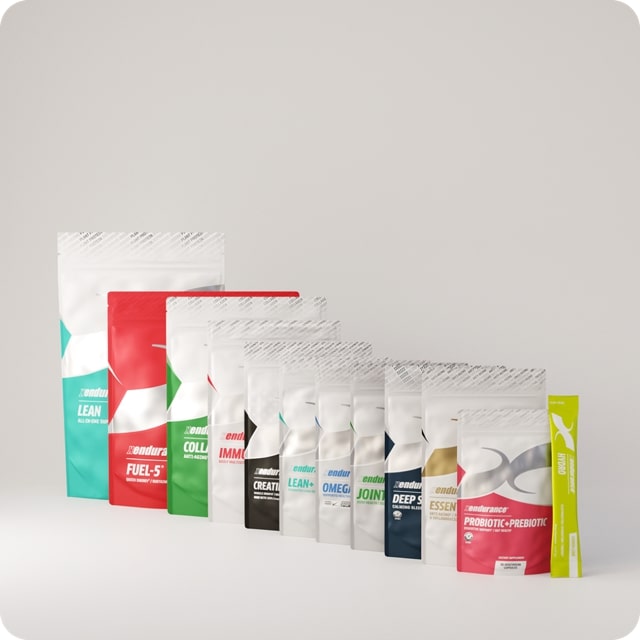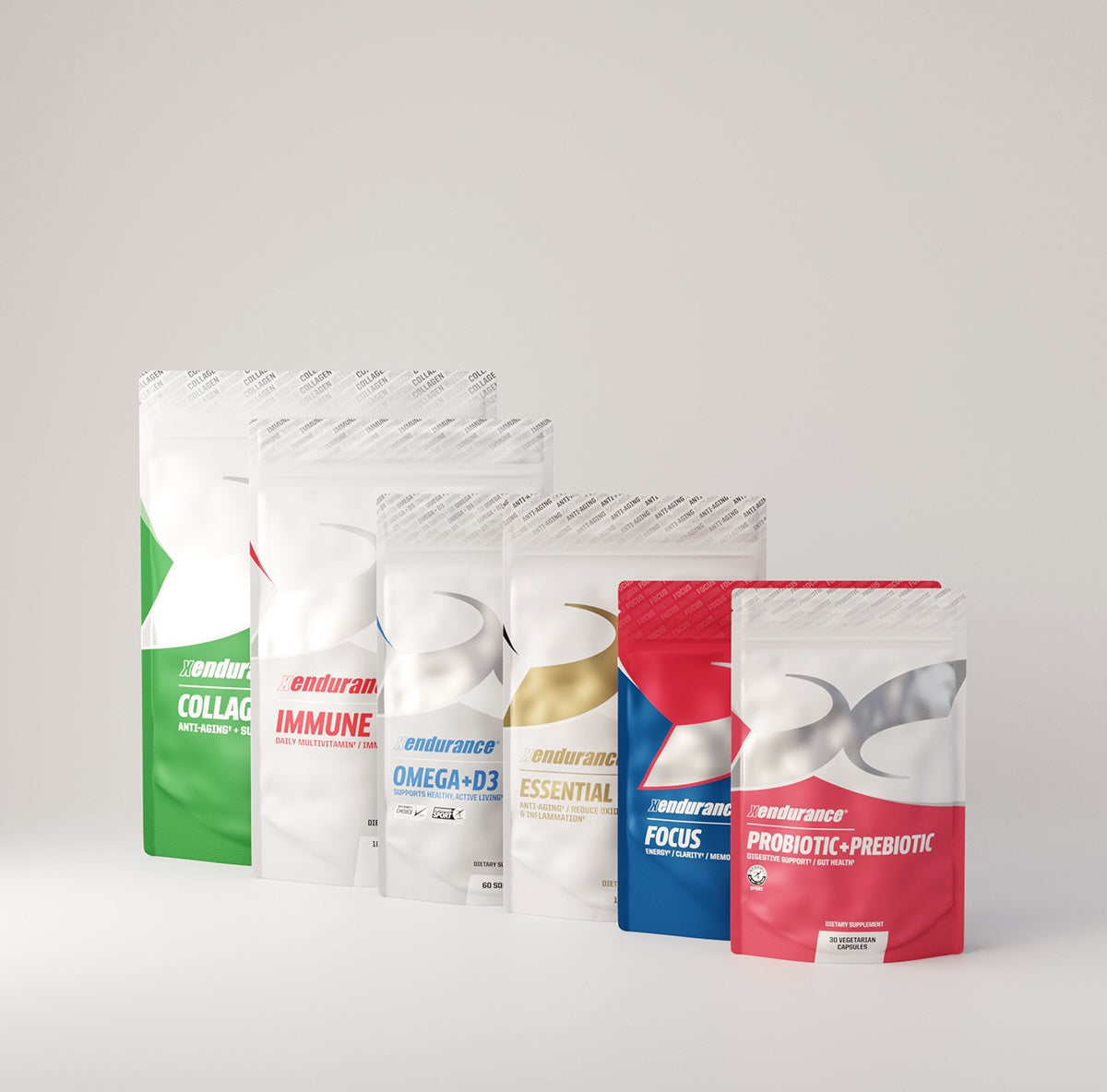You might be thinking that joint problems only affect the older generation? Wrong! While joint problems are common among older folks, everyone can experience joint pain or joint related issues. Bone health is a very important necessity - for all ages. Bones are the foundation to keep us standing upright and keep us moving. Preventative and ongoing joint and bone care is crucial to maintaining a healthy body. So whether you’re looking to ease some joint issues or just found out you need help strengthening your bone density, this blog will actually help you determine proper bone and joint health care and which nutrients to take.
Why Do Your Bone And Joints Matter?
Think about your daily movements; walking, sitting, running, bending over and picking up your children. Bones support movement and they protect the heart, brain and other organs from being damaged. Bones also store important minerals such as calcium and phosphorus and they can release these nutrients into the body when needed.
If you end up with a broken bone, it takes time to heal and this can cause loss of work, missing out on vacations and even being able to drive to the grocery store. Bones keep you mobile and keep your life on track. They matter!
Joints matter too. Your joints allow you to bend your knees, hips, elbows and more. Joints are the connections between the bones and they can wear out from getting older but they can also wear down from overuse or injury. Healthy joints help your bones glide over one another and keeps the bones from rubbing against each other.
Do you know anyone who has had a knee replacement? Probably… and these surgeries are usually done when the pain is constant and there is “bone on bone” contact in the knee. Ouch..If the joints and cartilage (and synovial fluid) is still healthy, many times no knee pain is felt. And we have all heard of arthritis; osteoarthritis, rheumatoid arthritis, and even gout. Arthritis is considered any disorder that affects the health of the joints. Old people, young people, any of us are at risk if you don’t keep your joints healthy. Let’s discuss causes and solutions!
Common Causes of Bone And Joint Problems
Some of the more common causes of bone and joint health issues are:
Age creeps up on all of us. Bones just wear out over time. And each year over 300,000 older people—those 65 and older—are hospitalized for hip fractures. 2.4 million hip and knee surgeries were done in 2021. Fractures and replacements aren’t all tied to age but a good portion are.
Occupation can put some people in the path of injuries. Common work-related injuries treated in an emergency department were injuries with objects and equipment, overexertion, falls and slips and trips without a fall. In 2020 there were 2.7 million nonfatal workplace injuries. Hmm, maybe time to start getting your resume out there and make a job change?
Activity Levels such as sitting at a desk, standing at a desk, a policeman on a beat or a mailman on their feet can be a signal to think about preventative bone and joint health. If you sit all day at your desk your activity levels are lower, your bones and joints may not be getting the exercise needed to keep them healthy. Standing or walking all day may provide the exercise needed for healthy bones and joints but are you getting the nutrition to support this?
Genetics can also play a part in bone and joint health. Let’s discuss arthritis. There can be a genetic component to arthritis but most diseases aren’t determined by genetics alone. Many of us inherit genes that can turn into diseases and that is where a healthy lifestyle is so important. Why turn on a disease gene if you can prevent it with making good life choices!
Environmental Influences such as smoking is the strongest known environmental risk factor for rheumatoid arthritis (RA). Exposure to air pollution increases the risk of osteoporosis and long-term exposure to black carbon was associated with an excess of longitudinal bone loss. Also toxins cause health problems, such as environmental exposure to various endocrine disruptors (bisphenol A, phthalate esters, etc.), ever-changing organic compounds, and heavy metals to name a few. So maybe consider where you live for your bone and joint health and well-being.
And Lifestyle is a big one! Do you exercise? Or are you sedentary and maybe overweight? Do you have enough calcium and vitamin D in your diet? Do you take supplements for bone and joint health? And do you smoke? There are multiple lifestyle changes that can be made to improve bone and joint health.
Bone And Joint Care Tips: Prevention and Aid
Proper nourishment of bones and joints is one of the most important things you can do to prevent issues from arising. Bone and joint supplements are everywhere, so how do you know what vitamins are good for bone and joint health? What vitamins should you take for joints? What vitamins to take for bones?
Let’s look at some well documented ingredient research for joints. Here are four ingredients to discuss. When taken at research dosages they are highly effective to:
- Glucosamine – Strengthens healthy cartilage that cushions your joints*
- Chondroitin – Helps reduces cartilage breakdown & promotes rejuvenation*
- Boswellia – Powerful anti-inflammatory that helps relieve joint soreness*
- Methylsulfonylmethane (MSM) – Helps minimize joint discomfort & speeds-up recovery*
Glucosamine & Chondroitin have years of clinical research showing effectiveness. A 2015 study, Effectiveness and safety of Glucosamine, chondroitin, the two in combination, or celecoxib in the treatment of osteoarthritis of the knee, showed symptomatic efficacy of glucosamine plus chondroitin in the treatment of knee OA. (1)
Boswellia research over the years show positive results in the treatment of OA. The Boswellia serrata tree is commonly found in India. The therapeutic value of its gum (guggulu) has been known for possessing good anti-inflammatory, anti-arthritic and analgesic activity. In a 2006 study( 2) the observed differences between drug treated and placebo were significant and Boswellia was recommended in the patients of osteoarthritis of the knee with possible therapeutic use in other arthritis.
Methylsulfonylmethane (MSM) helps with joint discomfort and also with OA. Knee osteoarthritis affects the lives of millions of people all over the world. A 2006 study (3) provided long-sought validation that MSM is a safe and effective option for people who want to improve their joint health. Since that study you see more and more MSM joint supplements in combination with other joint ingredients such as Glucosamine & Chondrotin and more people are searching out bone and joint supplements because they are finding relief.
Vitamin D is a very important supplement for bone health. It is vital to keep bones strong by helping with the absorption of calcium and phosphorus which are crucial for bone health. The milk manufactured in the US is fortified with vitamin D. You can also find vitamin D in fortified breakfast cereals, eggs, and vitamin supplements. If you do not get enough vitamin D in your diet there are consequences. Children can develop a condition called rickets, which cause skeletal deformities, bone weakness and bowed legs. Sunshine is also another source of vitamin D. If you get about five to 30 minutes of sunlight between 10 a.m. and 3 p.m. twice a week you will get a good dose of vitamin D. But most of us are using sunscreen and do not get enough sunshine to produce what is now believed to be a higher amount of vitamin D needed than previously thought.
Calcium is crucial! We have all seen the “Got Milk” commercial and it is one way the dairy industry promotes strong bones. Every cell in the human body needs calcium to store for your blood and cells. If you don’t get enough calcium, your body takes it from your bones thereby weakening them. When you are in your 20’s your bones are the strongest they will be so it is imperative to take vitamins for bone health that contain calcium as you age.
Phosphorus is as important as calcium. The two together work to help strengthen and build your bones. Phosphorus is important structural support for nucleic acids and cell membranes and is involved in the body’s energy production. So as you look to improve bone and joint health, Phosphorus is of great importance.

Exercise and Diet and Why It Is Important For Bone & Joint Health
Exercise is also one of the most important things for optimum bone and joint health. If you don’t use it, you lose it!
There is a common misconception that movement will make already painful joints worse, but low impact movement actually helps to ease stiff joints. Low impact activities like walking, swimming, or yoga are great ways to keep joints moving and healthy. Increasing your range of motion or increased flexibility can alleviate stiffness and inflammation in the joints.
And if you are one of those rare people with no stiffness or bone issues and you continue to exercise, stretch and keep moving, you will strengthen the muscles around your joints and help maintain your bone strength. This is called prevention!
Diet and figuring out what foods are good for your bones and joints is essential.
Some foods help build bone density, strengthen connective tissue and reduce inflammation which in turn can help you prevent injuries and protect your joints for a long, active life.
Here are a few of those recommended foods; Anything with omega-3 fatty acids including cold water fish and vitamins, high antioxidant fruits such as blueberries, cruciferous vegetables like mustard greens, arugula and kale (has been known to block an enzyme that causes swelling in the joints) nuts & seeds (known for being high in omega-3 fatty acids) olive oil (more Omega-3s), lentils and beans which are a great sources of anthocyanins – that super flavonoid that reduces inflammation, AND lets not forget dark chocolate…okay we had to throw that in for chocolate lovers but dark chocolate has antioxidants that can counteract genetic predisposition to insulin resistance and inflammation. There are many more beneficial foods but notice these are all healthy (organic type) foods.
Maintain Proper Weight
By 2030, approximately 50% of American adults are expected to be considered obese. That is double the amount over the past 30 years. What impact does obesity have for joint and bone health? Being overweight attributes a multitude of problems for joint and bones.
Think about this. If a person is just 10 lbs overweight, it adds an extra 40 lbs of pressure on their knees. A person who is 100 lbs overweight has 400 lbs!!! of pressure on their knees. No wonder joints wear down faster and bones are slowly damaged with all the weight from being obese. And this is a chronic problem for adults in the United States. It’s not surprising that number of knee and hip replacements in this country. Imagine what losing weight would do for medical costs and knee replacements. Imagine what it would do for your bone and joint health if we all lost just 10 lbs?
Stop Smoking and Drinking Excessive Alcohol
Bone density is greatly effected by smoking. You smoke - your bones become weaker.
If you drink alcohol and have 2-3 drinks per day, this also effects the strength of your bones. Those few drinks impacts how much your body can absorb vitamin D and calcium which is important for healthy bones. There are many other reasons to stop smoking ad limit alcohol consumption but many do not realize the effect this has on healthy bones and joints.
Where To Start With Improving Bone and Joint Health?
You might be thinking, where do I start and how do I improve bone and joint health?
Many of the mentioned causes of poor bone and joint health are just good things to work on for overall health. Try NOT to become a statistic in knee replacement surgery for 2023. But don’t become overwhelmed. Start slowly with maybe diet and throw in more exercise or walking. Don’t sit for long periods of time without getting up and moving your joints. At the grocery store make sure you pick up some omega-3 foods and more nuts and seeds. Ask yourself if you are getting enough vitamin D? What about calcium? Maybe supplements for strong bones and joints should be considered for prevention? Concentrate on just diet and exercise and you will be amazed at your overall energy and how it will make it easier to prevent the wear and tear on your body.
(1) Zeng C, Wei J, Li H, et al. Effectiveness and safety of Glucosamine, chondroitin, the two in combination, or celecoxib in the treatment of osteoarthritis of the knee. Sci Rep. 2015;5:16827. Published 2015 Nov 18. doi:10.1038/srep16827
(2) Phytomedicine. 2003 Jan;10(1):3-7. Efficacy and tolerability of Boswellia serrata extract in treatment of osteoarthritis of knee--a randomized double blind placebo controlled trial. Kimmatkar N(1), Thawani V, Hingorani L, Khiyani R.
(3) Source: LS Kim et al., “Efficacy of Methylsulfonylmethane (MSM) in Osteoarthritis Pain of the Knee: A Pilot Clinical Trial,”
Journal of Osteoarthritis and Cartilage 14 (March 2006): 286-294.









Leave a comment
This site is protected by hCaptcha and the hCaptcha Privacy Policy and Terms of Service apply.